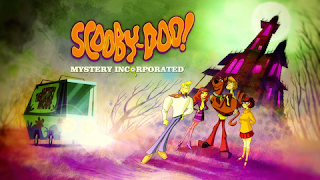5 Reasons You Should be Watching Scooby Doo Mystery Incorporated
 As I've mentioned from time to time, I often look for inspiration as a Dungeon Master from a variety of different sources, and I'm always on the lookout for inspiration from unlikely channels.
As I've mentioned from time to time, I often look for inspiration as a Dungeon Master from a variety of different sources, and I'm always on the lookout for inspiration from unlikely channels.Recently, as I was trying to introduce my 5yr old son to Scooby Doo, one of the cartoons I loved as a kid, and I found myself seeing the show as a wonderfully plotted long term Dungeons and Dragons campaign.
Now, just to clarify. When I was growing up, I was watching reruns of the original Scooby Doo, Where Are You! show, which, while good for its time, had some shortcomings in terms of story and animation. The show I was trying to introduce to my son to was the 2010 Scooby Doo! Mystery Incorporated (henceforth abbreviated as SDMI). After the first episode, I was hooked, not just as a TV fan, but also for the story telling techniques that I could borrow for my own D&D games.
Now, here are a few reasons you should be watching Scooby Doo! Mystery Incorporated right now!
- Easy Availability - This is a simple one, but still important. Unlike some other shows I might want to recommend for DM inspiration, this one is currently available for instant streaming on Netflix, lending itself to binge watching. As a DM, you could easily borrow the outline of one or two episodes (with a few minor changes) for entry level parties.
- Balancing Story of the Week and Ongoing Story - Most episodes included not only the monster/villain of the week, but also clues and details about a much larger mystery the group would investigate and solve by the end of the series (a refreshing aspect few of the other incarnations of the show follow). Watching how this unfolds and how seemingly inconsequential details all add together can offer inspiration and suggestion for DMs on how to do the same things in their own campaigns.
- Character Arcs - In addition to the monster of the week and the overarching story lines, SDMI also develops the background stories of many of the main and recurring characters seamlessly into the story of the week. Once again, all DMs can use these techniques to weave character backgrounds, either directly (like encountering a past villain) or indirectly (upholding a personal ideal), into any adventure they are running.
- Real Consequences - Unlike many of the other Scooby Doo shows before or after SDMI, this show had characters suffer real consequences over the course of the series, including the heavily implied death of several key characters. All D&D campaigns can be strengthen by reminding the players of their own mortality through the death of key or beloved NPCs.
- Setting Consistency - One of the best things I liked about this show over any other incarnation of Scooby Doo was how it took effort to be consistent in its setting and explain that consistency to the viewer. Thorough the course of revealing the overarching story, the show explains why Crystal Cove (the home base for this party) is so prone to strange events and even why Scooby (and a few other animals) can speak. It's often said that DMs can craft settings as fantastical as their imagination will allow, but those settings must be consistent. With SDMI, we learn the rational of some of the more fantastical elements presented.
Several episodes featured characters from other HB shows, including Jonny Quest, Blue Falcon and Dynnomutt. One episode in particular featured a bunch of characters from other similarly-themed HB detective shows, including Speed Buggy, Jabberjaw, and Captain Caveman.
Lastly, the show makes great reference to other shows and movies, from Terminator, Tremors, Buffy the Vampire Slayer, and even Star Trek, to name a few.
If you have a Netflix account, and some time to kill (the series consists of 52 episodes, each running about 22 minutes), I highly recommend checking this out.

